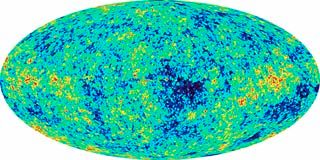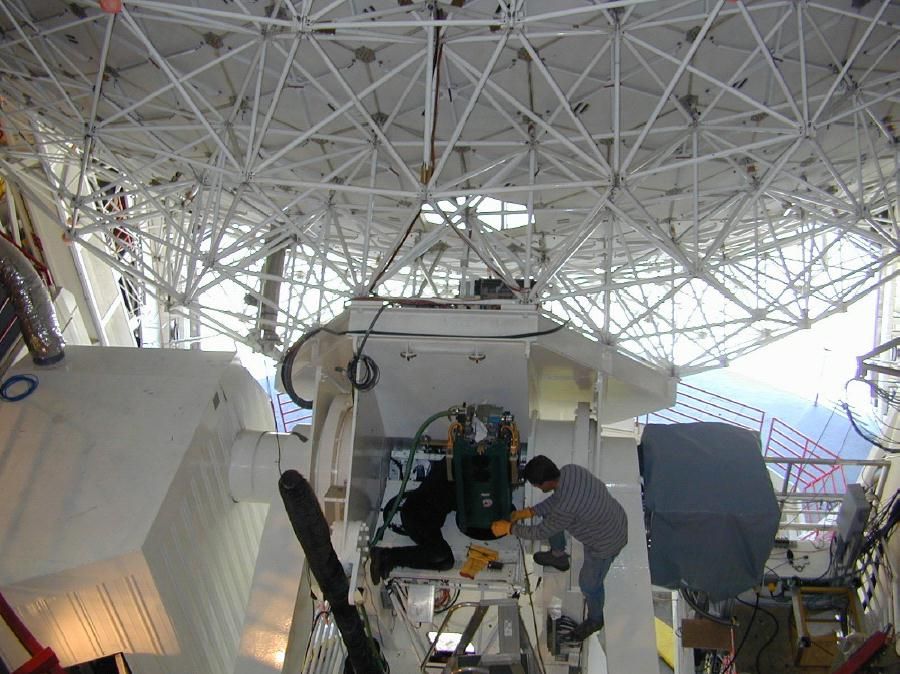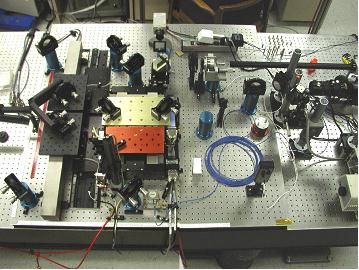Observational Cosmology Research
Observational Cosmology Research
 Cosmic Microwave Background (CMB) Research: Studies of the CMB
from space have produced ground-breaking results on the conditions in
the early universe. The CMB research group in ASD led the COBE mission
(including the Project Scientist, Principal and Deputy Investigators of
the FIRAS and DIRBE instruments, and Deputy PI for the DMR instrument).
The WMAP mission
is a collaborative project between GSFC/ASD and
Princeton University to map the microwave sky at 44 times the
sensitivity and 33 times the angular resolution (13 arcmin) of COBE.
Scientific papers from the first year of operation were published in a
special issue of the ApJ, and included such results as: (1) full sky
maps of the temperature anisotropy, (2) constraints on models of
structure formation, the geometry of the universe and inflation, (3)
detection of reionization after the Dark Ages, (4) accurate values of
many cosmological constants, and (5) initial results on the
polarization of the CMB. WMAP is still operating and taking high
quality data. Results from the first 2 full years of data will be
released in 2004. The CMB group in the Observational Cosmology Laboratory includes Bennett, Fixsen
(SSAI), Hill (SSAI) Hinshaw, Kogut, Limon (SSAI), Mather, Mirel (SSAI),
Moseley, Odegard (SSAI), Weiland (SSAI), and Wollack.
Cosmic Microwave Background (CMB) Research: Studies of the CMB
from space have produced ground-breaking results on the conditions in
the early universe. The CMB research group in ASD led the COBE mission
(including the Project Scientist, Principal and Deputy Investigators of
the FIRAS and DIRBE instruments, and Deputy PI for the DMR instrument).
The WMAP mission
is a collaborative project between GSFC/ASD and
Princeton University to map the microwave sky at 44 times the
sensitivity and 33 times the angular resolution (13 arcmin) of COBE.
Scientific papers from the first year of operation were published in a
special issue of the ApJ, and included such results as: (1) full sky
maps of the temperature anisotropy, (2) constraints on models of
structure formation, the geometry of the universe and inflation, (3)
detection of reionization after the Dark Ages, (4) accurate values of
many cosmological constants, and (5) initial results on the
polarization of the CMB. WMAP is still operating and taking high
quality data. Results from the first 2 full years of data will be
released in 2004. The CMB group in the Observational Cosmology Laboratory includes Bennett, Fixsen
(SSAI), Hill (SSAI) Hinshaw, Kogut, Limon (SSAI), Mather, Mirel (SSAI),
Moseley, Odegard (SSAI), Weiland (SSAI), and Wollack.
Kogut (PI), Fixsen, Limon, Mirel, and Wollack of ASD, in collaboration with Levin (JPL), Seiffert (JPL), and Lubin (UCSB) launched the Absolute Radiometer for Cosmology, AStrophysics, and Diffuse Emission (ARCADE), a balloon-borne instrument to measure the spectrum of the CMB at centimeter wavelengths. ARCADE searches for the signature of heating from the first generation of stars to form after the Big Bang. Successful flights in 2001 and 2003 showed the CMB to follow a blackbody spectrum down to 3 cm wavelength. A second-generation instrument is under construction and will launch in 2005. Recently, Kogut (PI), Fixsen, Hinshaw, Limon, Moseley, Wollack (all ASD), Devlin (U Penn), and Irwin (NIST) were awarded a NASA/ROSS grant to fly a high-altitude balloon payload (PAPPA) to measure the polarization anisotropy of the CMB. The flight will search for the imprint of gravity waves produced during an inflationary epoch in the early universe and also characterize the polarized Galactic foregrounds. Hinshaw (PI) leads a mission concept study for the Inflation Probe (aka CMBPOL), one of the Einstein Probes in the "Beyond Einstein" initiative in NASA's Structure and Evolution of the Universe theme. The goal of the inflation probe is to measure the amplitude of the B-mode polarization in the early universe, as direct support for the Inflation theory and to measure of the energy scale of Inflation. Hinshaw (PI) is the Director of the Legacy Archive for Microwave Background Data Analysis (LAMBDA) Data Center, which strives to provide one-stop shopping for the CMB research community.
| ||
 Development of far-IR detectors: Moseley, Benford, Shafer (665) are
engaged in developing detectors for the
HAWC and
SAFIRE
instruments on
SOFIA.
Ground based prototype instruments FIBRE and SHARC-II are
being developed in the Observational Cosmology Laboratory and tested at the
California Submillimeter Observatory (CSO) in Hawaii.
SHARC-II is a 350
micron camera featuring a
Development of far-IR detectors: Moseley, Benford, Shafer (665) are
engaged in developing detectors for the
HAWC and
SAFIRE
instruments on
SOFIA.
Ground based prototype instruments FIBRE and SHARC-II are
being developed in the Observational Cosmology Laboratory and tested at the
California Submillimeter Observatory (CSO) in Hawaii.
SHARC-II is a 350
micron camera featuring a
 12x32 array of doped silicon pop-up bolometers, developed by Moseley et al
at GSFC, cooled with He to 0.3 K. FIBRE (Fabry Perot Interferometer
Bolometer Research Experiment) is a scanning Fabry Perot (R~1000) cooled
to 1.5K for observation in the 350-450 micron window. The Observational Cosmology Laboratory is
responsible for the detectors, cryostat, and data acquisition interface with
CSO. FIBRE is shown at left in the lab at the ASD. Installation of
SHARC-II at CSO is shown on the right. SHARC-II is being developed
jointly by ASD/GSFC and Caltech. FIBRE collaborators include several
institutions in France, ASD/GSFC and Caltech.
12x32 array of doped silicon pop-up bolometers, developed by Moseley et al
at GSFC, cooled with He to 0.3 K. FIBRE (Fabry Perot Interferometer
Bolometer Research Experiment) is a scanning Fabry Perot (R~1000) cooled
to 1.5K for observation in the 350-450 micron window. The Observational Cosmology Laboratory is
responsible for the detectors, cryostat, and data acquisition interface with
CSO. FIBRE is shown at left in the lab at the ASD. Installation of
SHARC-II at CSO is shown on the right. SHARC-II is being developed
jointly by ASD/GSFC and Caltech. FIBRE collaborators include several
institutions in France, ASD/GSFC and Caltech.
| ||
 Wide-Field Imaging Interferometry Testbed (WIIT):
OCL members Leisawitz, Danchi, Mather, Rinehart, Gezari and Moseley (665)
(along with co-investigators from UMd, JPL, and NRL)
are developing WITT in support of design studies
for NASA's future space interferometry missions, in particular the SPIRIT
(SPace InfraRed Interferometric telescope) and
SPECS (Submillimeter
Probe of the Evolution of Cosmic Structure) far-infrared/submillimeter
interferometers. WIIT operates at optical wavelengths and uses Michelson
beam combination to achieve both wide-field imaging and high-resolution
spectroscopy. It will be used chiefly to test the feasibility of using a large-
format detector array at the image plane of the sky to obtain wide-field
interferometry images through mosaicing techniques. In this setup each
detector pixel records interferograms corresponding to averaging a particular
pointing range on the sky as the optical path length is scanned and as the
baseline separation and orientation is varied. The final image is constructed
through spatial and spectral Fourier transforms of the recorded
interferograms for each pixel, followed by a mosaic/joint-deconvolution
procedure of all the pixels. In this manner the image within the pointing
range of each detector pixel is further resolved to an angular resolution
corresponding to the maximum baseline separation for fringe measurements.
Wide-Field Imaging Interferometry Testbed (WIIT):
OCL members Leisawitz, Danchi, Mather, Rinehart, Gezari and Moseley (665)
(along with co-investigators from UMd, JPL, and NRL)
are developing WITT in support of design studies
for NASA's future space interferometry missions, in particular the SPIRIT
(SPace InfraRed Interferometric telescope) and
SPECS (Submillimeter
Probe of the Evolution of Cosmic Structure) far-infrared/submillimeter
interferometers. WIIT operates at optical wavelengths and uses Michelson
beam combination to achieve both wide-field imaging and high-resolution
spectroscopy. It will be used chiefly to test the feasibility of using a large-
format detector array at the image plane of the sky to obtain wide-field
interferometry images through mosaicing techniques. In this setup each
detector pixel records interferograms corresponding to averaging a particular
pointing range on the sky as the optical path length is scanned and as the
baseline separation and orientation is varied. The final image is constructed
through spatial and spectral Fourier transforms of the recorded
interferograms for each pixel, followed by a mosaic/joint-deconvolution
procedure of all the pixels. In this manner the image within the pointing
range of each detector pixel is further resolved to an angular resolution
corresponding to the maximum baseline separation for fringe measurements.
| ||
|
The Primordial Inflation Polarization Explorer (PIPER) is a balloon-borne instrument to measure the linear polarization of the cosmic microwave background in search of the signal from primordial gravity waves excited during an inflationary epoch shortly after the Big Bang. The existence of a gravity-wave background at detectable levels is a generic prediction of inflationary models.The detection of these gravity waves through their unique signature in the polarization of the remnant light from the Big Bang would have profound consequences for both cosmology and high-energy physics. Not only would it establish inflation as a physical reality, it would also provide a measurement of the relevant energy scale, probing physics at energies over a trillion times higher than accessible through particle accelerators. PIPER uses several technologies developed at GSFC. It carries 5120 superconducting detectors using the Backshort Under Grid (BUG) architecture.A variable-delay polarization modulator separates the incident radiation into unpolarized, linearly polarized, and circularly polarized components:PIPER will map over half of the sky in both linear and circular polarization.To reduce heat emission from the instrument itself, the twin telescopes are cooled to 1.5 K within a large (2 m diameter) open-aperture liquid helium dewar. PIPER will fly from a high-altitude scientific balloon at altitudes of 37 km in order to avoid emission from the Earth's atmosphere. The first of several planned flights will occur in 2012 from NASA's Columbia Scientific Balloon Facility launch site in Ft Sumner, New Mexico. | ||
| Optical Properties of Astronomical Silicates with Infrared Techniques (OPASI-T): Correct interpretation of a vast array of astronomical data relies heavily on understanding the properties of silicate dust as a function of wavelength, temperature, and crystallinity. The OPASI-T (Optical Properties of Astronomical Silicates with Infrared Techniques) project is designed to address the need for high fidelity optical characterization data on the various forms of astronomical dust. We use two spectrometers to provide extinction data for silicate samples across a wide wavelength range (from the near infrared to the millimeter). New experiments are in development that will provide complementary information on the emissivity of our samples, allowing us to complete the optical characterization of these dust materials. Together, we will use these apparatus to determine the optical constants for astronomically relevant materials such as amorphous iron silicate, magnesium silicate, and silica smokes over a wide range of wavelengths and temperature. | ||
The Legacy Archive for Microwave Background Data Analysis (LAMBDA), a part of the HEASARC, is a multi-mission NASA center of expertise for cosmic microwave background (CMB) radiation research. LAMBDA exists to serve the CMB research community, and the greater cosmological research community. In particular, LAMBDA:
| ||
|
Determining the Near-Infrared Extragalactic Background Light Through Absolute Measurements of the Zodiacal Light: We are developing a near infrared spectrometer for measuring solar absorption lines in the zodiacal light in the near infrared region. It has been recently demonstrated that observing single Fraunhofer lines can be a powerful tool for extracting zodiacal light parameters based on the measurements of the profile of the Mg I line at 5184 A.
We are extending this technique to the near infrared with the primary goal of measuring the absolute intensity of the zodiacal light. This measurement will provide the crucial information needed to accurately subtract zodiacal emission from the DIRBE (Diffuse Infrared Background Experiment) measurements to get a much higher quality measurement of the extragalactic infrared background. The instrument design is based on a dual Fabry-Perot interferometer with a narrow band filter. Its double etalon design allows it to achieve high spectral contrast, which is absolutely necessary to achieve detection limits needed to accurately measure the intensity of the absorption line. |

